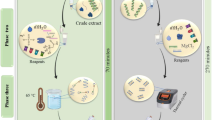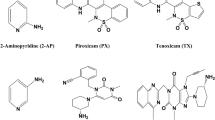Abstract
THE Kapeller-Adler1 method for the estimation of phenylalanine depends on the nitration of phenylalanine to give 3:4 dinitrophenylalanine; this is then reduced by alkaline hydroxylamine to a coloured nitroso derivative. It appeared probable that, by virtue of its phenylacetic radical, penicillin II (G) might be estimated in the same way and in the presence of penicillin I (F).
This is a preview of subscription content, access via your institution
Access options
Subscribe to this journal
Receive 51 print issues and online access
$199.00 per year
only $3.90 per issue
Buy this article
- Purchase on Springer Link
- Instant access to full article PDF
Prices may be subject to local taxes which are calculated during checkout
Similar content being viewed by others
References
Kapeller-Adler, R., Biochem. Z., 252, 185 (1932).
Hess, W. C., and Sullivan, M. X., Arch. Biochem., 5, 165 (1944).
Bratton, A. C., and Marshall, E. K., J. Biol. Chem., 128, 537 (1939).
Author information
Authors and Affiliations
Rights and permissions
About this article
Cite this article
PAGE, J., ROBINSON, F. Colorimetric Estimation of Penicillin II. Nature 158, 910–911 (1946). https://doi.org/10.1038/158910b0
Issue Date:
DOI: https://doi.org/10.1038/158910b0
This article is cited by
-
Beitrag zur photometrischen Bestimmung von Penicillin mit p-Dimethylaminobenzaldehyd
Fresenius' Zeitschrift für Analytische Chemie (1956)
Comments
By submitting a comment you agree to abide by our Terms and Community Guidelines. If you find something abusive or that does not comply with our terms or guidelines please flag it as inappropriate.



